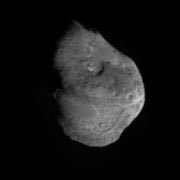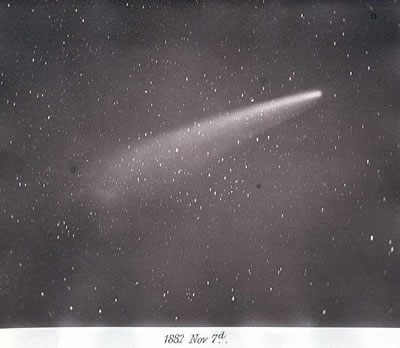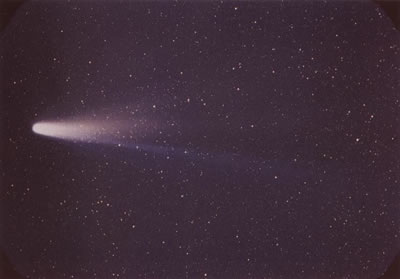Comets are small objects in the Earth's Solar System that are made up of three parts: the nucleus, the coma, and the tail.
 The nucleus, which is made up of frozen gases, water ice, rocks and dust, usually shines like a star. The coma is a cloud of gas and dust that surrounds the nucleus. The tail, which contains clouds of dust and ionized gases, streams away from the nucleus and the coma.
The nucleus, which is made up of frozen gases, water ice, rocks and dust, usually shines like a star. The coma is a cloud of gas and dust that surrounds the nucleus. The tail, which contains clouds of dust and ionized gases, streams away from the nucleus and the coma.
Some comets have short orbits (less than 200 years) and are called short period comets. They are believed to have been formed in the Kuiper Belt.
Long period comets, whose orbits range from 200 years to 30 million years, are thought to come from the Oort Cloud.
A comet's tail is always directed away from the Sun.
 When a comet comes very close to the Sun, a huge tail develops. This happened with the Great Comet of 1882.
When a comet comes very close to the Sun, a huge tail develops. This happened with the Great Comet of 1882.
A comet can have more than one tail, and it can lose its tail.
Old Human Beliefs About Comets
The Chinese thought that comets were ambassadors from the heavens. They made very careful records of their appearances and positions in the heavens.
Modern astronomers have used these records to trace comets back hundreds of years.
Europeans living in the Middle Ages thought that comets foreboded bad luck, such as plagues, civil wars and the death of kings.
It is said that William the Conqueror used the Comet of 1066 to his advantage, by telling his soldiers that the comet was a sign that a kingdom needs a king.
A comet that appeared in 1456 was believed to be related to the Ottoman conquest of Constantinople (now Istanbul).
 Halley's Comet
Halley's Comet
In his Principia Mathematica, which was published in 1687, Isaac Newton showed that comets, like planets, are subject to the laws of gravity.
In 1705, the astronomer Edmund Halley used Newton's work to prove that some comets return to the Sun at regular intervals.
Halley studied the orbits of 24 large comets, including one that had appeared in 1682. He found that, from the shape of its orbit, this comet seemed to be visible once in about 75 years, and that it had probably visited the sun on a former occasion.
He predicted that the comet would be seen again at the end of 1758 or the beginning of 1759.
On December 25, 1758, a German astronomer named Johann Georg Palitzsch became the first to see this comet, which is now known as Halley's Comet, on its next appearance